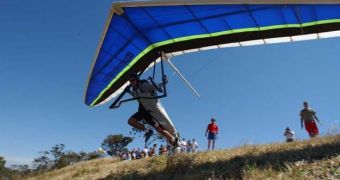When technology advances made humans to attempt flying during the 19th century, motorized flight proved impossible as the engines of those times were too heavy. The German engineer Otto Lilienthal tackled the issue differently: he first decided to perfect the art of gliding through air, achieving the required ascendant force from the air flow passing over the plane's wings and ascendant air currents. In 1881, with a pair of curbed wings made of fabric, Lilienthal run on the ground of a hill and launched in the wind. He managed a short flight of several hundreds of meters.
When the motorized flight developed at the beginning of the 20th century, the interest for gliding decreased till the '20s when competitions started to be organized.
The winged structures employed by Lilienthal were called hang gliders. Modern hang gliding started in the '70s, boosted by the space researcher Dr. Francis Rogallo. A conventional modern hang glider has a triangular wing made of polyamide fabric stretched over a light aluminium framework. The pilot hangs on a harness below the wing holding a control bar. By pressing the bar, the body weight is displaced backward, raising the front part of the glider. This increases the resistance against the wind and decreases speed. By pulling the bar, the front part bends down, decreasing resistance and increasing speed.
To change direction to the right or to the left, the glider is tilted on a sideway. Hang glider pilots usually run downward, against the wind, for taking off. Finding the right slope and waiting for the right wind can be boring and some hang glider pilots prefer to be pulled in the wind by a vehicle.
Modern proper gliders have slim wings, looking rather like an airplane than like a hang glider.
As the air over the cities, grasslands or crops is warmer, the glider takes height over these areas. Sea breeze can ascend the glider too. The forests and lakes are relatively cool, and the glider loses height over these surfaces.
Microlight planes are a type of glider having in front or rear something similar to the engine of a grass cutting machine, acting a propeller. A typical microlight plane has a glider type wing, an open simple cockpit and a landing undercarriage with wheels. Through basic commands, the plane can be handled even by unexperimented pilots. Most flights are made at altitudes of several hundreds meters with a speed of 50 km (30 mi) per hour. Advanced microlight planes can fly with 160 km (100 mi) per hour, for about 650 km (400 mi) (like the model Streak Shadow), with just 55 liters of fuel.
Some microlight planes have been modified to reach troops beyond the enemy lines lacking a crew, being controlled through radio and, thus, not risking lives.
Microlight planes can include many modern materials, like glass fibers or polycarbonates.
You could also fly using your own energy, a dream that humankind has had since ever. In 1977, Gossamer Condor, a light plane with a propeller acted by pedals, was the first to make 1.6 km (1 mi), gaining 50,000 pounds for its developers, Paul McCready and Peter Lissaman.

 14 DAY TRIAL //
14 DAY TRIAL //